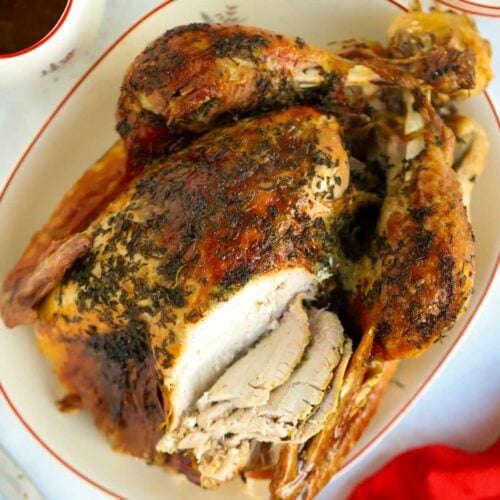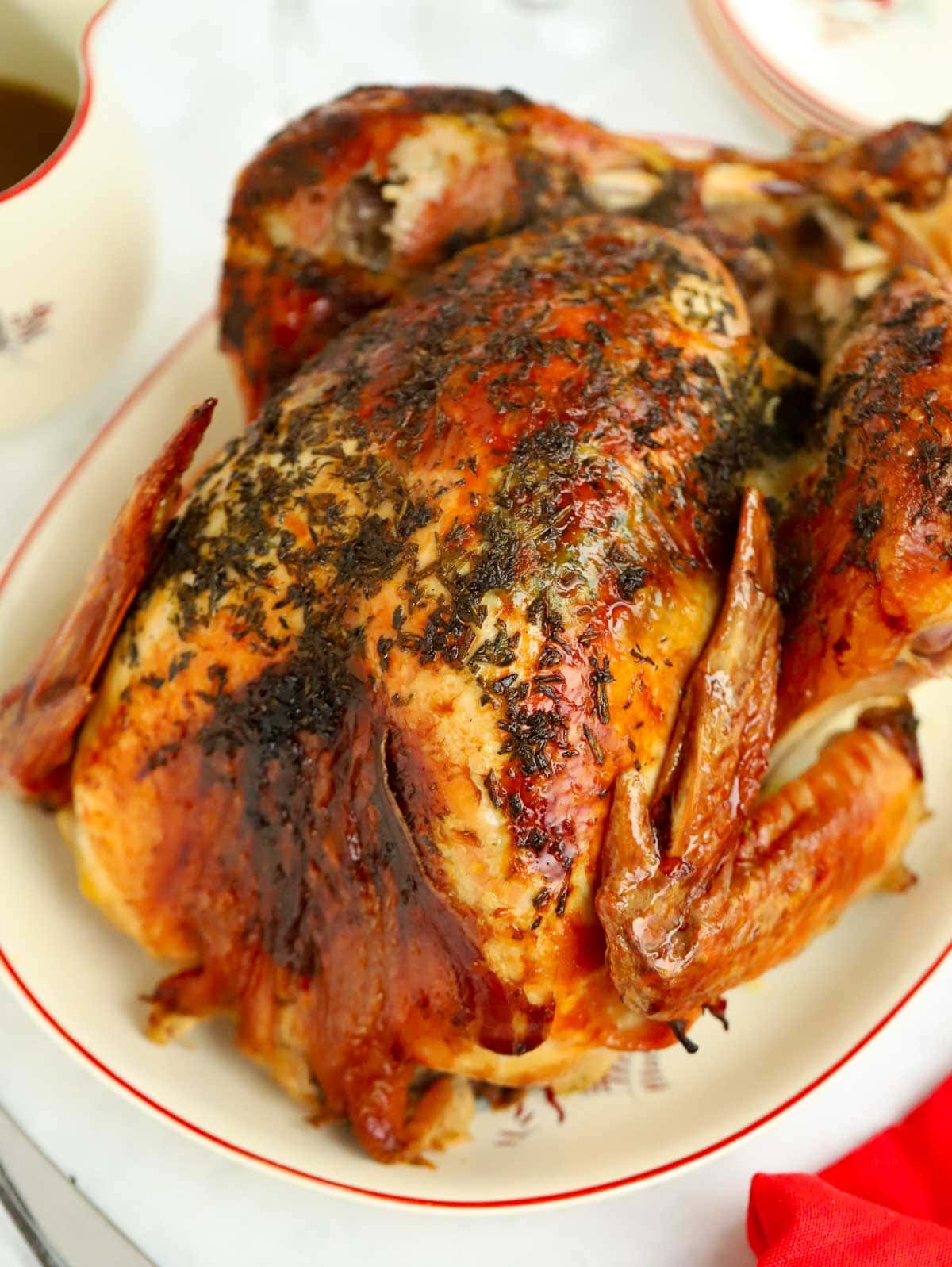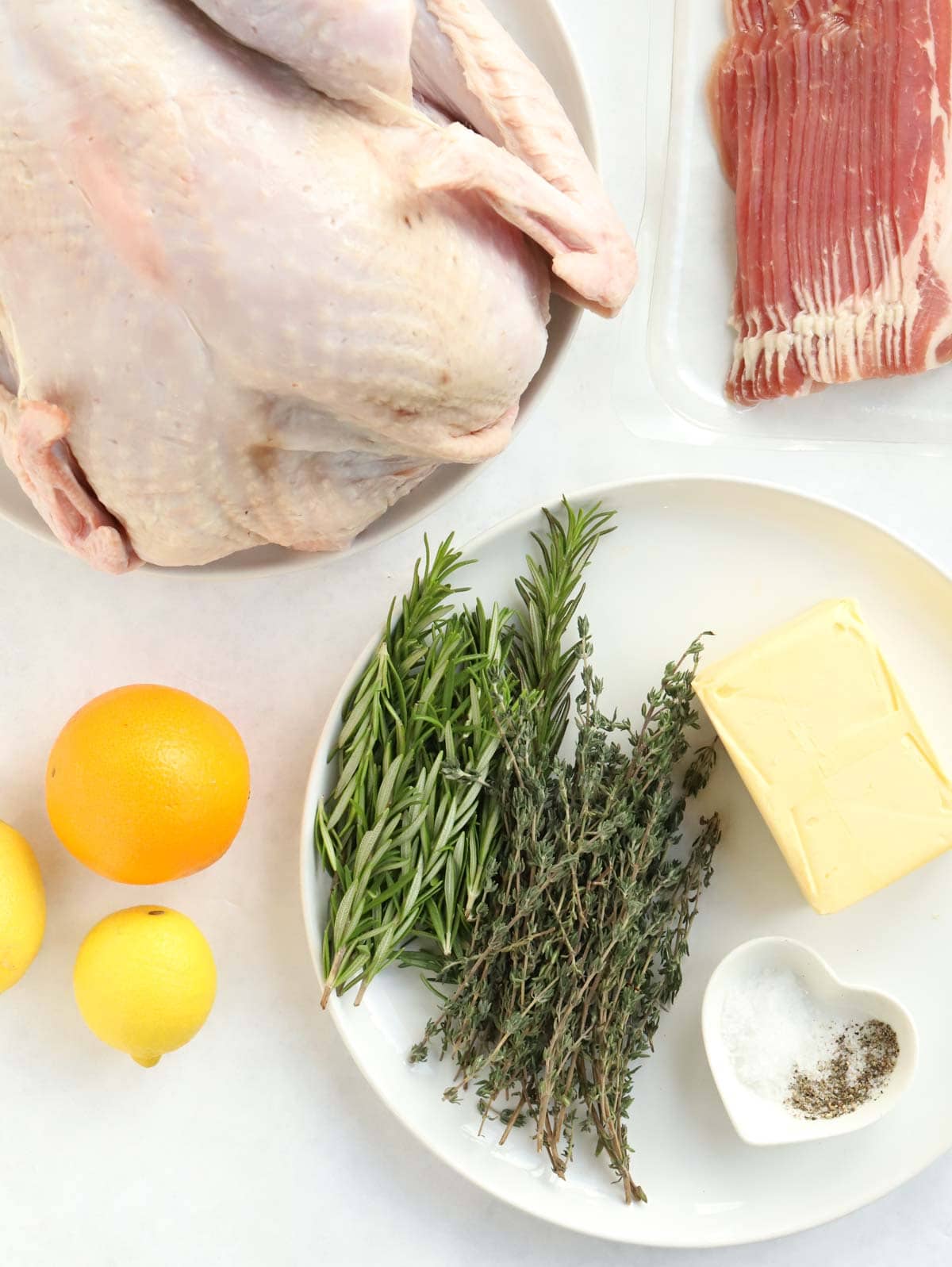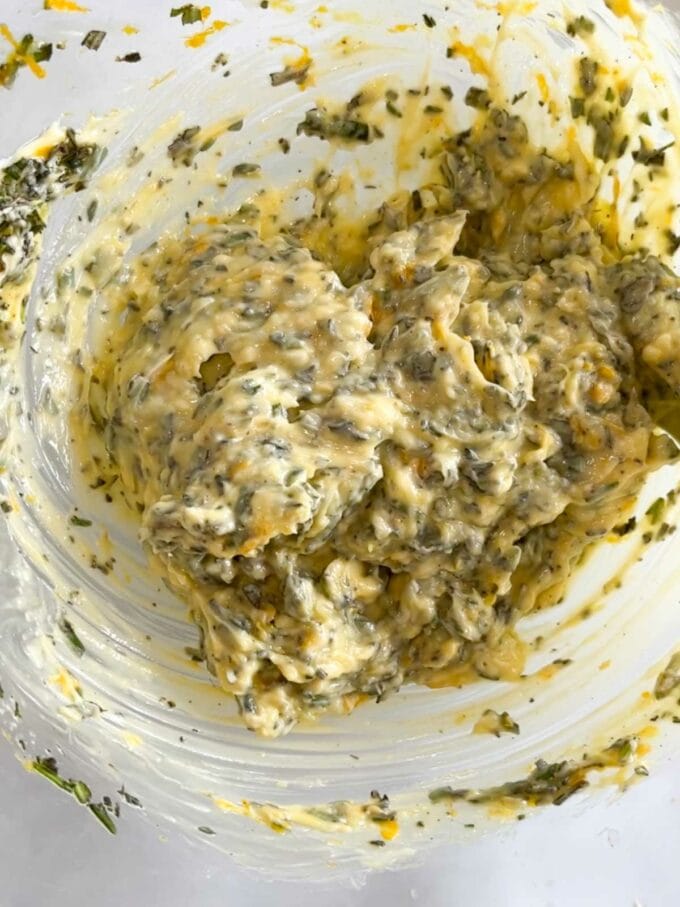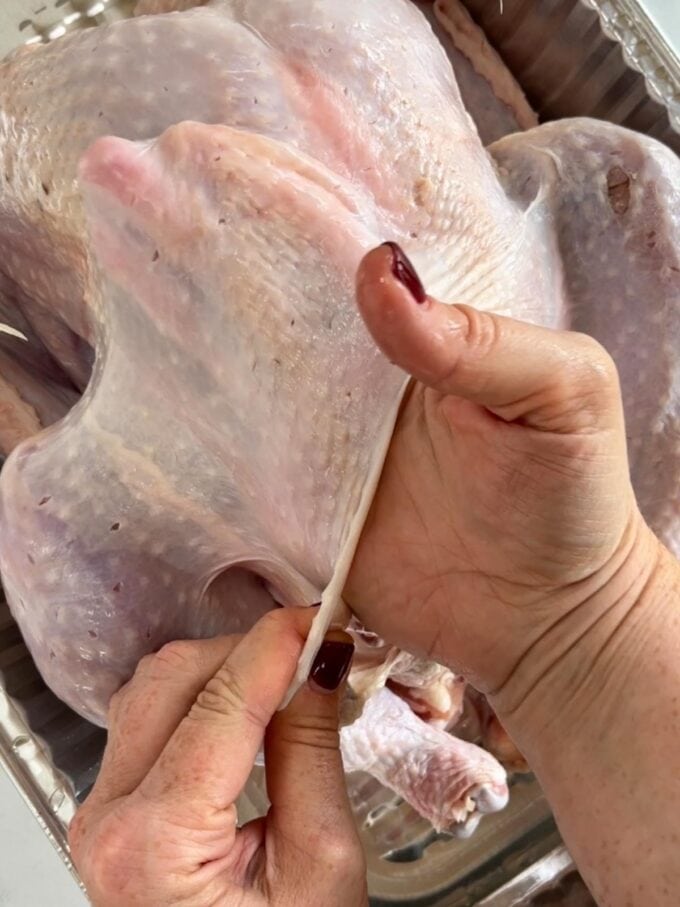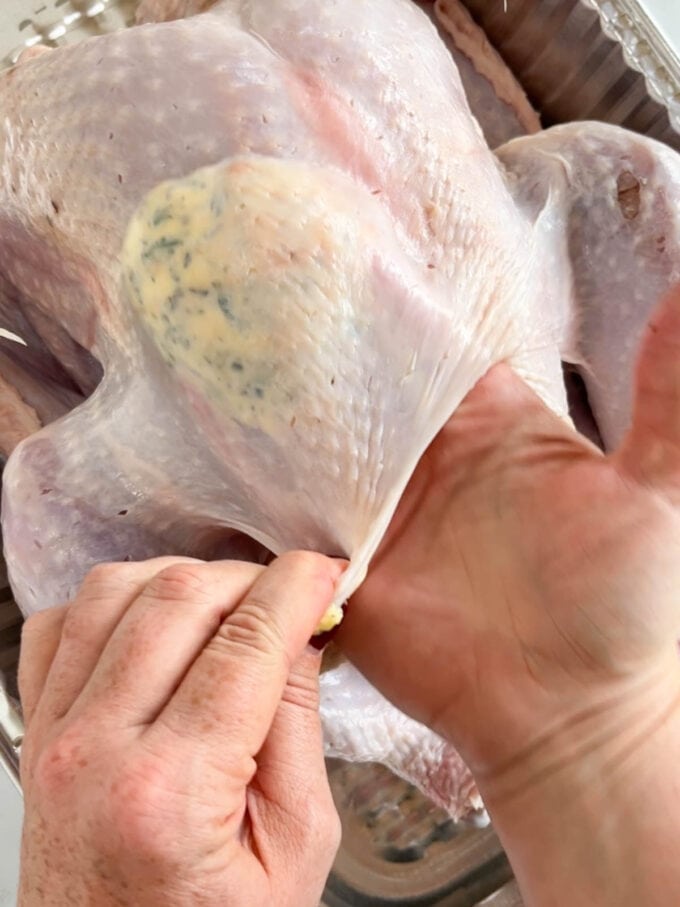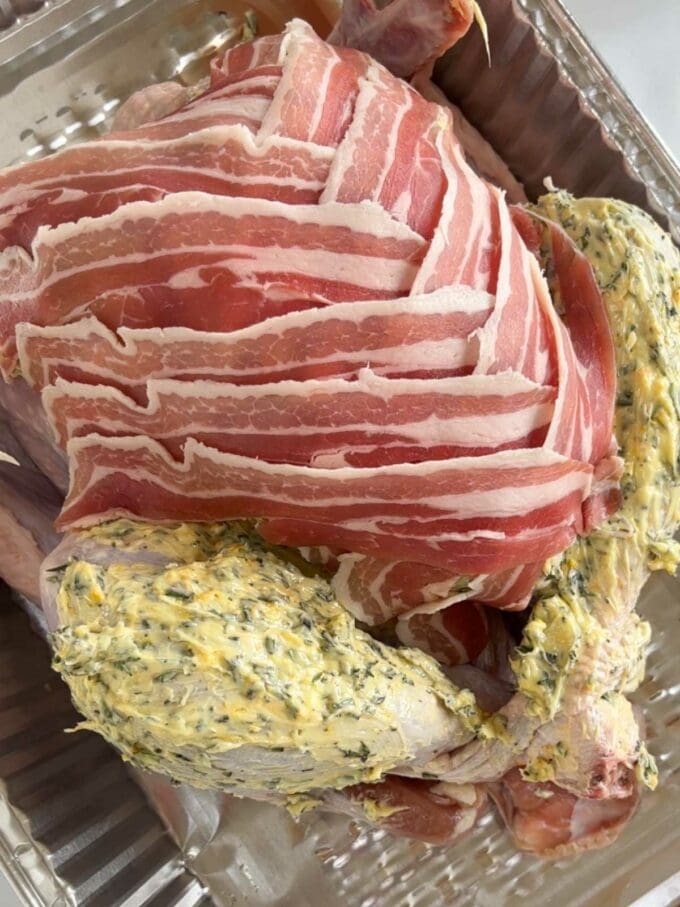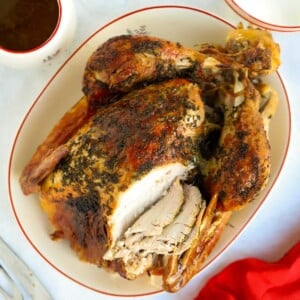This is your ultimate guide to how to cook a Christmas turkey without the fuss. I’ll hold your hand through the process and show you it doesn’t have to be stressful at all. Forewarned is forearmed – get those Christmas tunes on and enjoy your day. We’ve got this! Hosting Christmas dinner can be daunting and the weight of expectation of getting everything just right on a special day can be a tad overwhelming. Then there’s knowing how to cook a Christmas turkey – a large bird with a reputation for drying out that we don’t make the rest of the year… pressure much?! Well, I am here to tell you that roast turkey does NOT have to be complicated or stressful in order to be delicious, cooked on time, and actually cooked all the way through! THIS is how you serve up your roast turkey with zero fuss. This post will take you through everything, from how to prepare ahead, patting the bird dry to buttering and basting. If you don’t take away anything else from this guide, please do two things:
Why you’ll love this Christmas turkey recipe
⭐️ No fuss, no unnecessary frills, no drama ⭐️ Delicious, juicy and flavour-packed ⭐️ It’s the taste of CHRIIIIIISTMAAAAS! This is the secret to avoiding dry turkey. There are many weird and wonderful methods out there that people swear by for keeping that meat tender and moist(!), but we’re not bathing our turkey for a week here. A simple, flavoured compound butter mix made with herbs and zest, lathered underneath the skin before you cook it, is all that’s required. As well as the butter, streaky bacon rashers are the only extras I think a roast turkey needs to stay juicy, but it also adds flavour. By the time the bird has cooked, the bacon will be hard. You can always discard it if you like, but we always eat it crumbled over the meat! Understanding what size turkey to buy for the amount of guests you have is important so that you’re not selling anyone short or you don’t have a crazy amount of leftovers (if that’s even possible). It’s also crucial to know the size so you know how long to cook your turkey for, because different weights require different times in the oven. We’ll outline this in more depth further down. This is also a key component to getting your turkey just right, so it’s not undercooked or drying out. I cook turkey at 180℃, but the best thing to do is invest in a meat thermometer so you don’t have to guess how the bird is doing. I recommend this Thermapen thermometer. I have had lots that have broken, and while this isn’t the cheapest option, it’s the only one that’s lasted and has been consistently reliable. This just means spooning some of the fat that’s coming out into the tray over the meat. Do this every hour or so (or whenever you are passing the oven). This helps to stop it from drying out. Be aware that if you open the oven often, the turkey may take longer to cook though, as the heat escapes. This is a really important part of the whole process because the meat carries on cooking while it’s resting (its temperature rises at about another 10℃ in this time). It also adds extra flavour and juiciness during this time, as well as gives you time and space for the rest of the cooking. Time for resting should be roughly 1.5 hours for a 4-5kg turkey, up to about 2 hours for 6-10kg. Decide on how you’ll do this beforehand. Ceremoniously at the Christmas dinner table might be your dream scenario, but think about how you’ll go about it before it’s crunch time so you can get organised and have a carving dish and knife ready! A whole bird is a classic centrepiece that’s traditional and looks the part. It also offers a variety of meat and can feed plenty of people at once, so is therefore more economical (but probably costs more to buy). It also comes with a bit more work, faff and mess. A turkey crown is probably less hassle and easier to carve. It’s a good option if you’re not feeding many people or those you are feeding mainly prefer the white meat of the bird. It will also cook quicker and is good if you don’t have much room in your oven. It is cheaper and there’s little waste (but not as many leftovers), and there is an argument that it’s not quite as succulent without the legs and wings.
4kg serves 8-10 people 5kg serves 10-12 people 6kg serves 12-14 people 7kg serves 14-16 people 8kg serves 16-8 people 9kg serves 18-20 people
Cooking time
Weigh the turkey first so you get your timings correct. Preheat the oven to 180℃. According to the Food Standards Agency, you should cook your turkey by these guidelines:
Allow 45 minutes per kg plus 20 minutes for turkey under 4.5kg Allow 40 minutes per kg for between 4.5-6.5kg Allow 35 minutes per kg for over 6.5kg
Temperature
Use your meat thermometer to gauge whether your turkey is cooked or not. Always check the thickest part of the meat (usually the thigh). It will be ready when its temperature is recorded at either:
At 65°C for 10 minutes At 70°C for 2 minutes At 75°C for 30 seconds
Preparing in advance
Prep up to the end of step 3 up to 24 hours before you’re ready to cook the turkey. Cover and chill it overnight, then cook as normal in the morning. A fridge-cold turkey may take a little longer to cook than a room temperature one.
Thawing a frozen turkey
Plan this WELL in advance! Turkeys are hefty birds and take some thawing out – large ones can take up to 5 days! If you are cooking a frozen turkey, check the packet instructions beforehand, however most do need to be defrosted. According to official guidance from the Food Standards Agency, you should always defrost your turkey in a fridge rather than room temperature. You’ll need to put it in a container in case any liquid comes out to avoid cross-contamination (and a messy fridge!) If you don’t have thawing instructions, allow about 10-12 hours per kg for a complete thaw.
Room temperature
Remove the turkey from the fridge and leave it at room temperature for about an hour before you’re going to cook it. This stops it from reacting and shrinking in the hot oven.
Take out the giblets
These are basically the innards of the turkey and they’re usually inside the bird in a bag, so you just need to pop them out. You don’t need them for your turkey, but they’re great for additional flavour in your gravy if you want to go the extra mile.
How to rest your turkey
When the turkey is cooked through do the following:
Remove from the oven but leave in its tray (lots of juice will come out) Put it on the side somewhere not too chilly in the kitchen Keep the tin foil covering Pop a clean bath towel or a couple of clean tea towels on top of the tin foil to seal and keep the heat in. Let it rest for abotuo When you’re ready to serve, pour the juices into your gravy (if you wish) Put on a platter and carve.
Carving
You can either carve it the traditional way, which is to remove the legs and wings and carve along the grain of the breast. OR you can remove the breasts by cutting them out of the carcass in one whole piece and slicing it on a board. Start on one side of the breast and cut downwards diagonally until you reach the centre. For the legs and wings, carve the meat until you get to the joint, then put your thumb in the gap and pull the joint away. Also I’d LOVE to see your cooking creations. If you’d like to share yours with me, you can tag me on Instagram (@tamingtwins).
